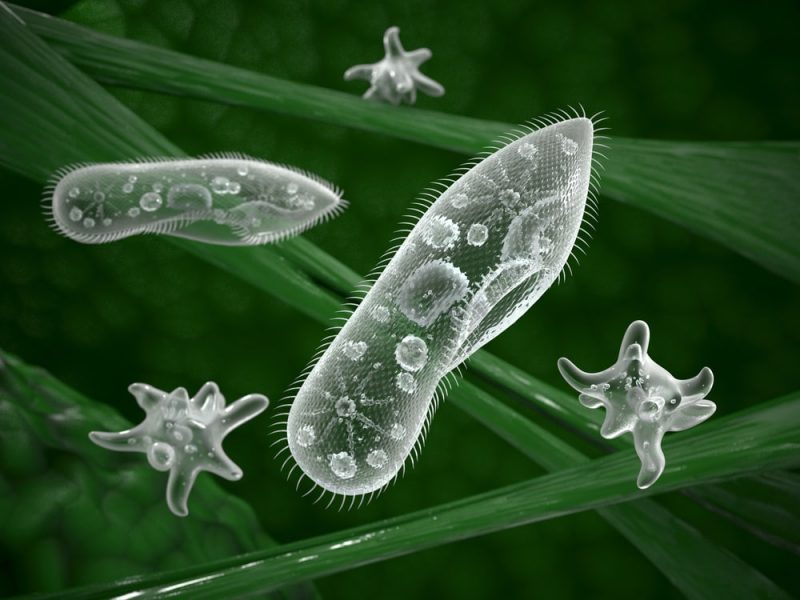The microscopic organisms (also called microorganisms) are the smallest living beings that inhabit the planet, those that can only be seen through a microscope. They are organisms endowed with individuality whose biological organization, unlike animals and plants, is elemental and in many cases only has one cell. For instance: paramecium, poxvirus, escherichia coli.
Between the features The possibility of rapid metabolic reactions appears from microorganisms (transporting themselves very quickly through membranes and diffusing in cells), and also rapidly reproducing them, in some cases dividing every twenty minutes.
Also, precisely because of this fast playback, alter the environment that surrounds them through sudden and rapid changes by eliminating waste from cellular metabolism: in this same sense, they develop modes of resistance that make them survive at great depths in sediments, hundreds of meters and millions of years buried.
The world around us is largely made up of microorganisms, but these were only discovered when work began with magnifying glasses or microscopes in different areas of scientific work.
Some of them meet a symbiotic function with the host beings that host them (such as bacteria in the intestinal tract) while others, in the opposite sense, are harmful to health (such as viruses that produce a response in the immune system).
Types of microscopic organisms

Microorganisms that are capable of penetrating and multiplying in other living beings that they harm are called pathogenic microorganisms. They are divided into three groups:
- Bacteria. Single-celled organisms belonging to the monera kingdom, with a shape that can be spherical or spiral. They are one of the most abundant units of life on Earth, but they can only be seen through a microscope. Its functional role is specific, in some cases carrying out the degradation of organic matter and in others integrating its metabolism with that of human beings. Sometimes they cause various diseases.
- Parasitic protozoa. Unicellular organisms that are characterized by a complex metabolism. They feed on solid nutrients, algae, and bacteria that are present in multicellular organisms like animals and humans. Many times this class of pathogens are resistant to chlorine disinfection, and the way to eliminate them is with filtration and the application of sodium hypochlorite.
- Virus. Ultramicroscopic biological systems (even smaller) that can cause infections, and only reproduce in host cells. They are characterized by having a protective layer, and can also have a spiral or spherical shape. They only contain one type of nucleic acid, and they cannot reproduce on their own but require the metabolism of the host cell. Unlike bacteria, all viruses are pathogenic and therefore harmful to health: they cannot be eliminated with antibiotics.
The immune system it is the body’s natural defense against infection. Through a series of steps, this system fights and destroys invading infectious organisms before they cause harm, many of which are microscopic organisms. Both the elderly and the very young are more easily attacked by these microscopic organisms, since the immune system is weakened.
Examples of microscopic organisms
- Paramecium (they move through short structures like small hairs)
- Herpes simplex virus – cold sore (virus)
- Staphylococcus aureus
- Colpoda
- Myxovirus Mumps (causes mumps)
- Falvobacterium aquatile
- Proteus mirabilis (urinary tract infection)
- Variola virus (generates Smallpox)
- Didinium
- Saccharomyces Cerevisiae (used to make wines, breads, and beers)
- Blepharocorys
- Mycobacterium tuberculosis
- Rotavirus (causes diarrhea)
- Ascetosporea that is characterized by inhabiting marine invertebrates.
- Beta hemolytic streptococci (tonsillitis)
- Giardia lamblia (Protozoan microorganisms)
- Balantidium
- Poxvirus (causes molluscum contagiosum disease)
- Streptococcus pneumoniae (causes pneumonia)
- Yeasts (fungi)
- H1N1 (virus)
- Coccidia that frequent the intestines of animals
- Schizotrypanum
- Toxoplasma Gondii, which is transmitted by undercooked red meat.
- Poliovirus (Poliomyelitis)
- Amoebas (protozoan microorganisms)
- Bacillus thuringiensis
- Entodinium
- Haemophilus influenzae (causes meningitis)
- Eimeria (characteristic of rabbits)
- Salmonella typhi
- Enterobacter aerogenes
- Chloroflexus aurantiacus
- Papilloma virus – warts (virus)
- Herpes simplex (herpes simplex)
- Azotobacter chroococcum
- Molds (fungi)
- Rhinovirus – flu (virus)
- Pediastrum
- Rodospirillum rubrum
- Varicella Zoster Virus (Varicella)
- Paramecia (Protozoan microorganisms)
- HIV (Human Immunodeficiency Virus)
- Plomarium Malarie (transmitted by the bite of a mosquito).
- Hemosporidia (live in red blood cells)
- Volvox
- Human immunodeficiency virus – AIDS (virus)
- Clostridium tetani
- Escherichia coli – Produces diarrhea (bacteria)
- Arbovirus (encephalitis)
